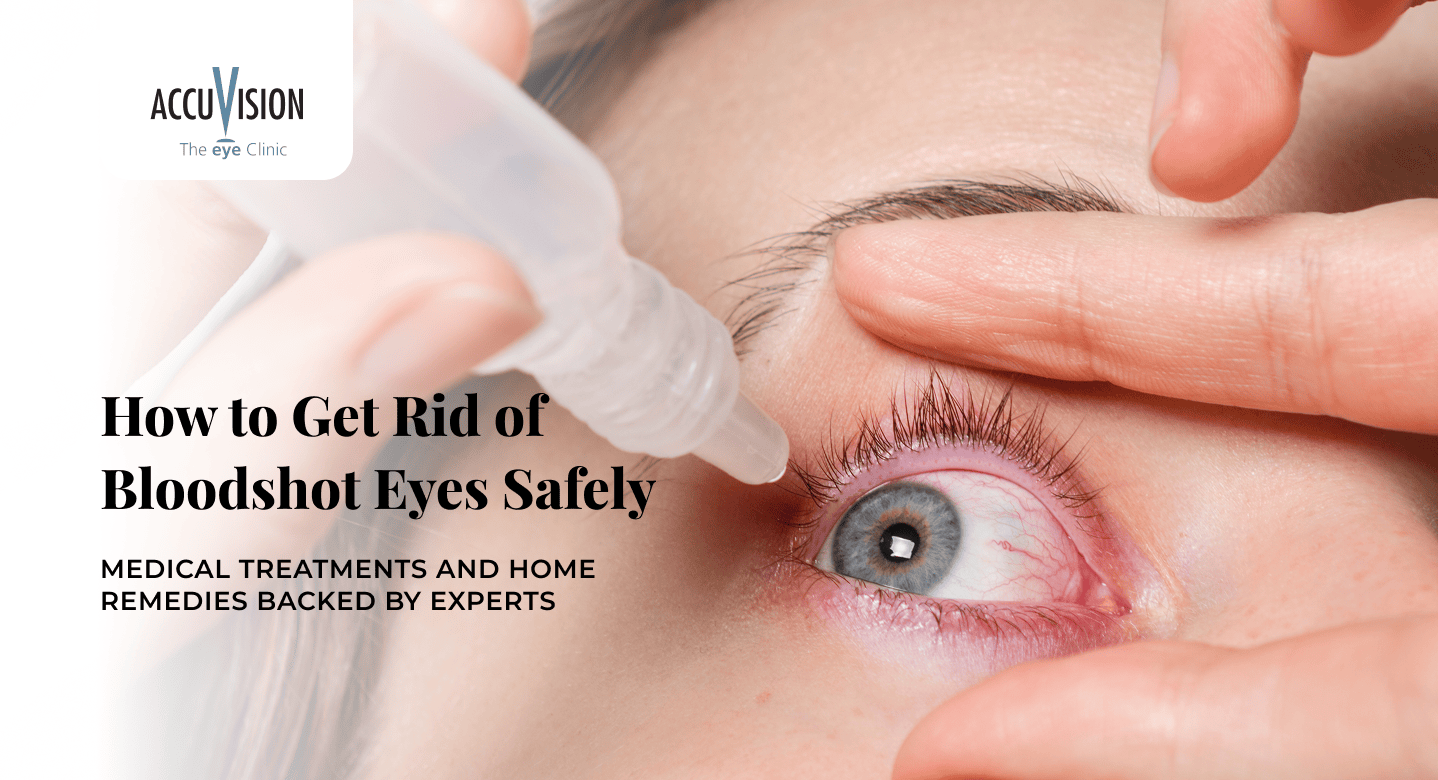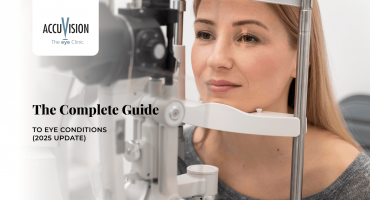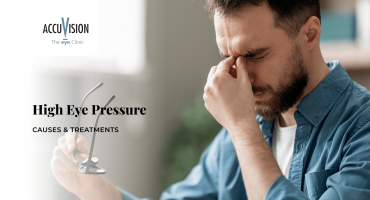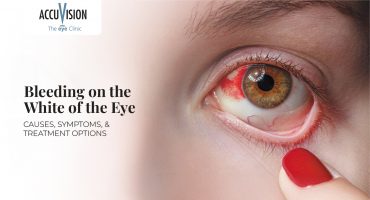- Understanding Bloodshot Eyes: What Causes Eye Redness?
- Common Causes of Bloodshot Eyes
- When to Seek Medical Attention for Bloodshot Eyes
- Medical Treatments for Bloodshot Eyes
- Safe Home Remedies for Bloodshot Eyes
- Common Mistakes That Worsen Bloodshot Eyes
- Preventing Recurrence of Bloodshot Eyes
- Conclusion
- FAQs
How to Get Rid of Bloodshot Eyes Safely: Medical Treatments and Home Remedies

Waking up to red spots in the eyes can be concerning. The good news is that in most cases, those red, irritated eyes are nothing to panic about.
Bloodshot eyes are typically a symptom rather than a condition in themselves. The redness happens when tiny blood vessels on the surface of the eye become enlarged, making the white part appear red or bloodshot. Common culprits include lack of sleep, excessive screen time, allergies, or environmental irritants like smoke and dust.
That said, not all eye redness is harmless. In some cases, redness can indicate a more serious underlying issue, such as inflammation, infection, or changes in blood vessels, which require immediate medical attention.
This guide covers both medical treatments and safe home remedies for bloodshot eyes, all backed by evidence-based information. This information is educational and does not replace professional medical advice. If you’re experiencing eye redness or bleeding, a comprehensive eye examination by an eye specialist is advised to ensure your eyes are healthy and rule out any underlying conditions.
Understanding Bloodshot Eyes: What Causes Eye Redness?
The medical term for bloodshot eyes is conjunctival hyperaemia. Essentially, it means increased blood flow in the conjunctiva (thin, transparent membrane covering the white part of the eye).
When these blood vessels become inflamed or dilated, they’re more visible, giving the eye its characteristic red appearance. The intensity can vary from mild pinkness to pronounced red streaking across the entire eye.
Beyond the redness itself, other symptoms often tag along, including mild discomfort, watery eyes, itching, burning, or a gritty sensation that something’s in your eye.
Understanding what’s causing the problem is essential before trying any treatment. Different triggers need different approaches.
Common Causes of Bloodshot Eyes
Bloodshot eyes can stem from numerous triggers. Pinpointing the underlying cause helps determine the safest and most effective treatment.
- Lifestyle habits: Lack of sleep, dehydration, or long screen hours can leave the eye red and bloodshot.
- Environmental triggers: Smoke, dust, pollen, and pollution often irritate and inflame the eyes. +( Learn more about dry eye treatment.)
- Dry eye syndrome: Insufficient or poor-quality tears cause persistent redness and discomfort.
- Infections or inflammation: Conjunctivitis (infection of the thin eye lining) or blepharitis (inflammation of the eyelids) can lead to bloodshot, painful eyes needing medical care
- Serious eye conditions: A sudden bloodshot eye on one side may signal injury, glaucoma (dangerously high pressure inside the eye), or uveitis (inflammation of the inner eye) requiring urgent attention.
These conditions cannot be identified by simply looking in the mirror. It is advisable to book a thorough eye examination at AccuVision, where experienced specialists use advanced diagnostic technology to determine the exact cause of eye redness and provide appropriate care.
When to Seek Medical Attention for Bloodshot Eyes
Most red eyes settle down on their own, but some situations need a professional to take a look sooner rather than later:
- Redness that comes on suddenly and hurts or is affecting your vision.
- Just one eye has turned red with no obvious explanation.
- Thick, coloured discharges (yellow or green are particular red flags).
- Light becomes uncomfortable or painful to look at.
- The redness hasn’t budged after three or four days
- Your eye turned red after a physical injury to it
- The redness comes with a pounding headache or feeling sick.
- You’re seeing halos around lights, or your vision has changed suddenly.
Don’t ignore these signs. Getting checked quickly can detect infections, rising eye pressure, or other problems before they have a chance to damage vision.
Medical Treatments for Bloodshot Eyes
Eye care specialists have various treatment options available, depending on what’s causing the redness. These treatments should only be used under professional guidance.
-
Prescribed Treatment Options
For dryness-related redness, specialists may recommend lubricating eye drops or artificial tears. These help restore the tear film and soothe irritation. When allergies are the culprit, prescription anti-allergy drops can provide effective relief.
Bacterial infections require antibiotic eye drops or ointments. For specific inflammatory conditions, anti-inflammatory medications (including steroid eye drops) might be recommended, though these need careful monitoring due to potential side effects.
-
Specialist Interventions
Sometimes treating the root cause is necessary for resolution of recurrent redness. This might include managing blepharitis (eyelid inflammation) through eyelid hygiene routines or prescribed medication, treating meibomian gland dysfunction (blocked oil glands in the eyelids) with warm compresses, gland expression and in clinic treatments such as thermal pulsation or IPL, or correcting vision problems that cause eye strain.
Rarely, when abnormal blood vessels cause persistent redness, laser treatment performed by an Ophthalmologist may be considered. This specialist-only intervention is reserved for specific situations.
All prescription treatments should be used exactly as directed. Never share eye drops with others or use medications prescribed for previous conditions without current professional guidance.
Safe Home Remedies for Bloodshot Eyes
For mild, short-term redness triggered by lifestyle or environmental factors, these straightforward steps can often bring relief. These remedies work best when the cause is benign and temporary so you should check with your eye care professional before setting your routine with them
- Get proper rest: Seven to eight hours of quality sleep does wonders. Tiredness is one of the most common triggers for bloodshot eyes.
- Try the 20-20-20 rule: During screen time, look at something 20 feet away for 20 seconds every 20 minutes. This relaxes eye muscles and encourages blinking
- Keep eyelids clean: Use sterile lid wipes or diluted baby shampoo on a clean cotton pad. This removes debris and prevents irritation from building up.
- Use cool compresses: Soak a clean cloth in cool water, squeeze out the extra water, and place it gently over your closed eyes for five to ten minutes. This helps reduce swelling in the blood vessels.
- Dodge irritants: Limit exposure to smoke, dust, or strong fragrances. Protective eyewear helps when avoidance isn’t possible.
- Good contact lens hygiene: Never sleep with lenses in your eyes. Replace them on schedule and take them out if eyes are bloodshot.
- Drink enough water: Adequate hydration throughout the day supports healthy tear production, especially in air-conditioned or heated spaces
- Eat eye-friendly foods: Include omega-3 fatty acids (fish, flaxseeds, walnuts) and antioxidants (colourful fruits and vegetables) to help reduce inflammation
Common Mistakes That Worsen Bloodshot Eyes
Knowing what not to do is just as valuable as knowing what helps.
| Mistake | Why It’s Harmful | Better Alternative |
|---|---|---|
| Overusing decongestant “whitening” drops (drops that temporarily reduce redness) | Creates rebound redness and dependency | Use preservative-free prescribed tear drops instead |
| Ignoring persistent redness | May miss underlying conditions needing treatment | Seek professional assessment if not resolved within 1-2 days |
| Using old or contaminated eye drops | Risk of infection and further irritation | Check expiry dates; discard opened bottles after recommended period |
| Wearing contact lenses during irritation | Prevents oxygen reaching the eye; worsens symptoms | Switch to glasses until redness resolves completely |
| Rubbing eyes vigorousl | Can damage delicate vessels and introduce bacteria | Use clean compresses or prescribed tear drops for relief |
Preventing Recurrence of Bloodshot Eyes
Identifying personal triggers is the key to prevention. Once the patterns become clear, taking targeted steps to reduce recurrence becomes much easier.
- Maintain consistent eye hygiene: Clean eyelids regularly, especially when wearing eye makeup or working in dusty conditions. Remove all makeup thoroughly before bed.
- Optimise screen time: Position monitors at arm’s length and at eye level. Make sure lighting is adequate without creating screen glare.
- Try blue light glasses: Blue light filtering glasses or screen protectors might help reduce strain and redness
- Control the indoor environment: Use a humidifier when conditions are dry, particularly during winter. Keep air vents pointed away from the face
- Don’t share personal items: Eye cosmetics, applicators, towels, and eye drops should never be shared to prevent infection transmission.
- Book regular eye examinations: Have comprehensive eye examinations even when everything feels fine. Discuss recurrent bloodshot eyes with an optometrist to identify underlying causes.
- Shield eyes from UltraViolet (UV) exposure: Wear quality sunglasses blocking 100% of UVA and UVB rays when outdoors.
- Manage allergies proactively: For seasonal allergies triggering redness, discuss preventive antihistamine use with a healthcare provider before symptoms kick in.
Conclusion
Most bloodshot eyes are nothing serious and clear up with basic care; a good night’s sleep, plenty of water, and keeping eyes clean usually does the trick. But if the redness sticks around, is painful and does not improve after a couple of days, then that’s when professional help is needed.
The safest approach to bloodshot eyes is finding the root cause of the redness and then treating it. Home remedies are excellent for tiredness or minor irritation, but there’s no point delaying a proper assessment if symptoms linger long.
Are you experiencing persistent redness or noticing any of the previously mentioned warning signs? Book a comprehensive eye examination with an experienced specialist. It’s better to get peace of mind and proper treatment than to wonder if something’s wrong
This content was reviewed by the clinical team at AccuVision The Eye Clinic, a trusted UK-based centre for comprehensive laser vision correction and specialised eye care. With expert Ophthalmologists and Optometrists across the UK, AccuVision ensures that every article reflects accurate, medically reviewed information and supports evidence-based eye health awareness. This content is for general educational purposes only and should not be construed as medical advice. Always consult a qualified eye care professional for personalised guidance and treatment of specific conditions.
FAQs
1. What does it mean when my eye is red and bloodshot?
A bloodshot eye occurs when small surface blood vessels dilate due to irritation, dryness, or inflammation, making the white of the eye appear red or pink.
2. What causes a sudden bloodshot eye?
A sudden bloodshot eye may result from strain, dryness, or irritation, but if it appears without an obvious cause, especially in one eye, it could signal an underlying condition that requires prompt professional evaluation.
3. Why is my bloodshot eye only on one side?
A bloodshot eye on one side is often caused by local irritation or dryness but may occasionally indicate infection, injury, or inflammation, making a thorough eye examination advisable.
4. How can I get rid of bloodshot eyes safely?
To relieve mild redness, rest your eyes, stay hydrated, and use preservative-free lubricating drops. Persistent redness should always be assessed by an eye specialist to identify the underlying cause.
5. Are bloodshot eyes something to worry about?
In most cases, bloodshot eyes are temporary and harmless, but redness with pain, vision changes, or discharge should never be ignored and should be reviewed by a qualified optometrist or ophthalmologist.








